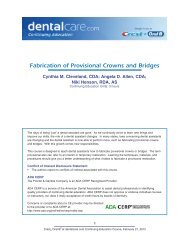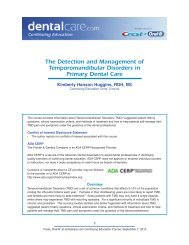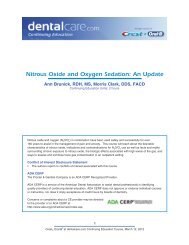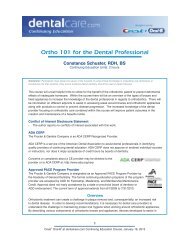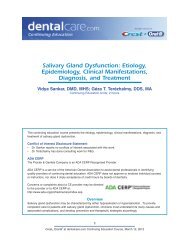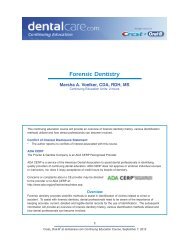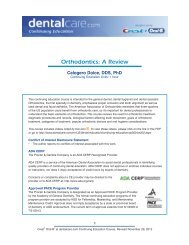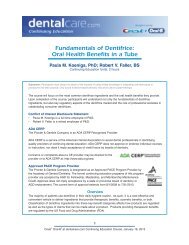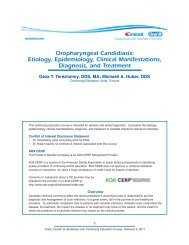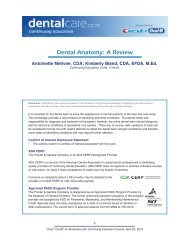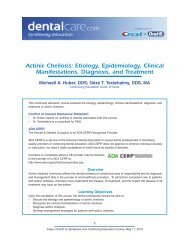CE 391 - Management of Pediatric Medical ... - DentalCare.com
CE 391 - Management of Pediatric Medical ... - DentalCare.com
CE 391 - Management of Pediatric Medical ... - DentalCare.com
Create successful ePaper yourself
Turn your PDF publications into a flip-book with our unique Google optimized e-Paper software.
It is possible for the patient to develop an<br />
anaphylactoid reaction which mimics a true IgE<br />
mediated anaphylaxis reaction. An anaphylactoid<br />
reaction is an idiosyncratic reaction that occurs<br />
when the patient is first exposed to a drug or<br />
other agent. Although it is not immunologically<br />
mediated, the emergency management is the<br />
same as a true anaphylactic reaction.<br />
There are a number <strong>of</strong> primary allergic agents<br />
used in dentistry:<br />
• Antibiotics (penicillins, sulfonamides):<br />
Parenterally administered penicillin can cause<br />
an anaphylactic reaction. Orally administered<br />
usually causes a delayed reaction. Patients<br />
may not realize they have been previously<br />
exposed to a sensitizing dose because the<br />
exposure could have been environmental, i.e.,<br />
penicillin mold in the air, meat and milk.<br />
• Analgesics (aspirin, codeine, NSAIDS):<br />
Symptoms can range from mild urticaria<br />
to anaphylaxis. Bronchospasm is the<br />
most <strong>com</strong>mon reaction. For patients with<br />
a known allergy to the above analgesics,<br />
acetaminophen should be prescribed.<br />
• Local anesthetics (esters, procaine,<br />
benzocaine): Injectable and topical ester<br />
local anesthetics have been primarily<br />
implicated in allergic reactions. Reported<br />
allergic reactions in amides are probably due<br />
to reactions to preservatives such as parabens<br />
and sodium metabisulfate.<br />
• Other agents: Acrylic resins (denture repairs)<br />
and latex (gloves, rubber dams) primarily<br />
cause contact dermatitis.<br />
An anaphylactic episode is exhibited by the<br />
following reactions:<br />
• Skin<br />
Urticaria - itching, hives (elevated patches <strong>of</strong><br />
skin)<br />
Erythema – rash<br />
Angioedema - localized swelling<br />
• Respiratory<br />
Bronchospasm - respiratory distress,<br />
wheezing<br />
Angioedema to the larynx leading to airway<br />
obstruction<br />
Rhinitis<br />
• Cardiovascular reactions<br />
Circulatory collapse due to vasodilation<br />
presented by light headedness, weakness,<br />
syncope and ischemic chest pain<br />
9<br />
Dysrhythmias - as above plus palpitations<br />
Cardiac arrest<br />
The progression <strong>of</strong> symptoms is:<br />
1. Skin<br />
2. Eyes, nose, GI<br />
3. Respiratory system<br />
4. Cardiovascular system<br />
Emergency <strong>Management</strong><br />
Should a patient experience an anaphylactic<br />
episode, the following steps should be taken:<br />
• Assess the problem: Recognize and<br />
acknowledge itching, hives, edema, flushed skin.<br />
• Discontinue treatment<br />
• Activate the <strong>of</strong>fice emergency system: Call<br />
for help and have oxygen and the emergency<br />
drug kit brought to the site <strong>of</strong> the emergency.<br />
• Position the patient: The patient should be<br />
positioned <strong>com</strong>fortably.<br />
• Assess airway and circulation: Assess the<br />
patient’s breathing and airway patency and<br />
adjust the head and jaw position accordingly.<br />
Monitor the patient’s pulse and blood pressure.<br />
Provide basic life support as needed. If the<br />
patient’s condition continues to worsen, contact<br />
emergency medical services.<br />
• Provide definitive care: Administer<br />
epinephrine. Epinephrine counteracts most<br />
<strong>of</strong> the effects <strong>of</strong> histamine. It produces<br />
bronchodilation, raises blood and the heart<br />
rate via its α and β effects and counters skin<br />
rash, urticaria and angioedema by an unknown<br />
mechanism.<br />
While available in 1 ml ampules <strong>of</strong> 1:1000 (0.30<br />
mg/dose) for adults and 1:2000 (0.15 mg/dose) for<br />
children that is drawn into and administered via a<br />
syringe, a more efficient manner <strong>of</strong> administration<br />
during an emergency is with an Epi-Pen.<br />
Epi-pen (0.3 mg epinephrine) and Epi-pen Jr<br />
(0.15 mg epinephrine) are preloaded epinephrine<br />
autoinjectors. They are extremely easy to use and<br />
are routinely available with prescription to the public<br />
for everyday allergic reactions (insect bites, food<br />
allergies).<br />
Directions for use are:<br />
1. Pull <strong>of</strong>f the blue safety release cap (Figure 2).<br />
2. Swing and firmly push the orange tip against<br />
the outer thigh so it “clicks”. HOLD the Epi-pen<br />
Crest ® Oral-B ®<br />
at dentalcare.<strong>com</strong> Continuing Education Course, May 11, 2012



